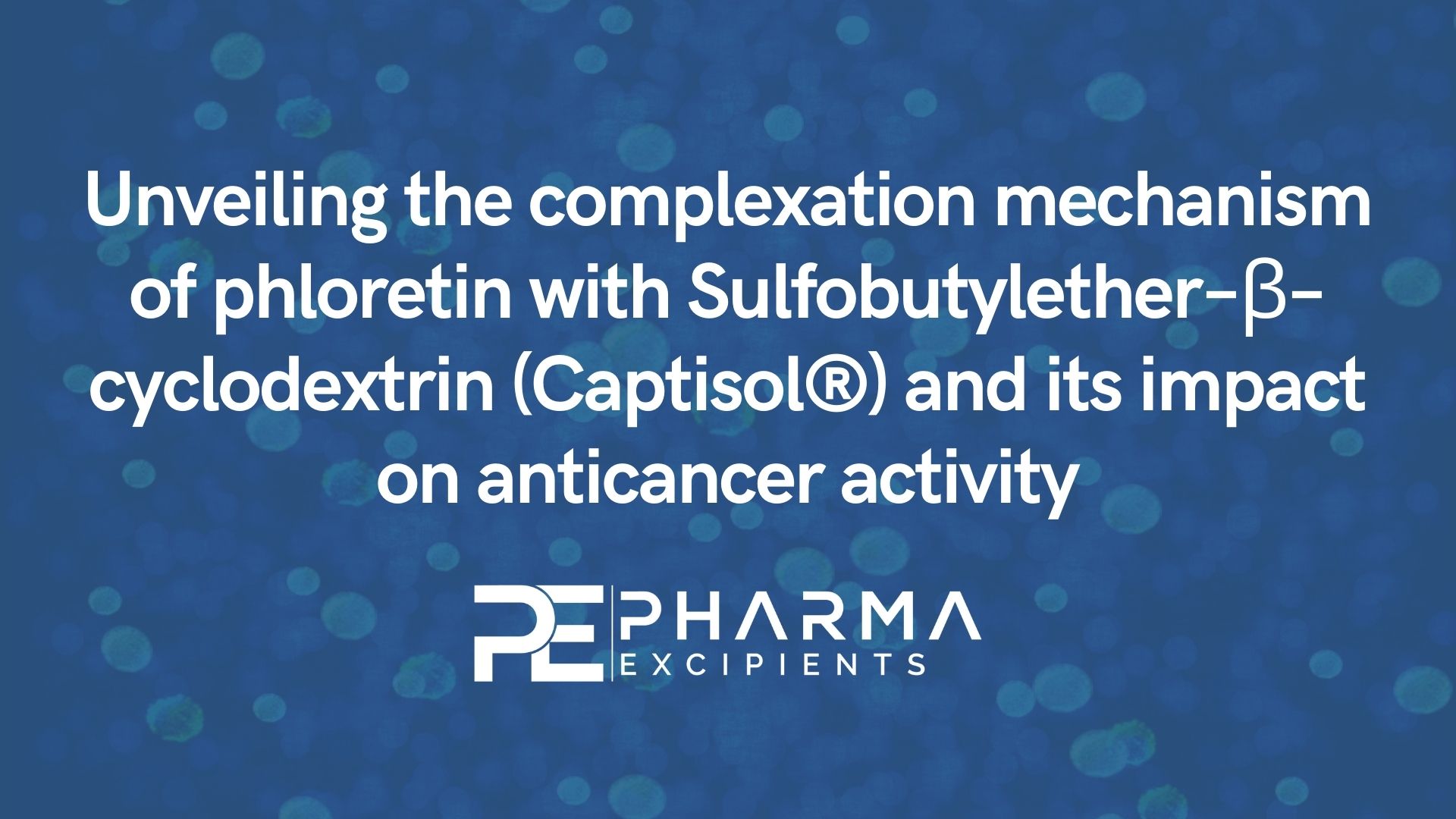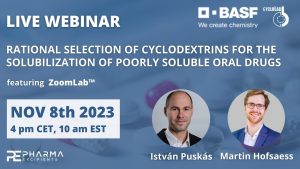Unveiling the complexation mechanism of phloretin with Sulfobutylether–β–cyclodextrin (Captisol®) and its impact on anticancer activity

Abstract
The incorporation of phloretin (PHL), a dihydrochalcone flavonoid, in functional foods is usually hampered by its low aqueous solubility. In this regard, we investigated the impact of complexation of PHL with sulfobutylether-β-cyclodextrin (SBE-β-CD, Captisol®) to overcome its limitation. The phase solubility studies of PHL with different β-CDs derivatives represents AL-type of curve where, SBE-β-CD demonstrated highest apparent stability constant (Ks: 15,856 M−1) indicating its strong affinity to form host-guest assembly. Solid-state characterizations (including SEM, FT-IR, PXRD, DSC, TGA) provided direct evidences of inclusion complex (IC) formation. The detailed molecular interaction between the host–guest assembly was performed using 1H NMR and 2D-NOESY revealed that protons of aromatic phenyl ring of PHL (guest) molecule exhibit direct correlation with the protons lying in the inner cavity of SBE-β-CD (host). Furthermore, the anticancer potential of PHL/SBE-β-CD-IC was examined using cytotoxicity studies, caspase 3/7 activation assay, reactive oxygen species (ROS) generation and disturbance in mitochondrial membrane potential (MMP) in lung carcinoma cell line (A549) and human pancreatic cancer cell line (MiaPaCa–2). The in-vitro cytotoxicity assay on both cell lines demonstrated higher antiproliferative activity of IC as compared to free PHL in concentration dependent manner. In addition, it was found that PHL/SBE-β-CD-IC induces apoptosis via activation of caspase 3/7, reactive oxygen species generation and inducing depolarization of mitochondrial membrane potential in both the cell lines (MiaPaCa–2 and A549). Overall, the study provides a promising approach to enhance the solubility and bioactivity of PHL utilizing SBE-β-CD inclusion complexation.
Introduction
Phloretin, (PHL) [3-(4-hydroxyphenyl)-1-(2,4,6-trihydroxyphenyl)propan-1-one], a crystalline dihydrochalcone naturally obtained from apples, kumquats, pears, and strawberries [1], [2]. It exerts panoply of pharmacological effects (including regulation of glucose transporters, free radical scavenging, and strong ability to induce apoptosis in tumor cells) due to its unique chemical structure that consist of two aromatic phenol rings (ring A and B), four hydroxyl and a carbonyl group [3], [4], [5]. Despite of its tremendous biological properties the application of PHL in food industry is constrained by its poor aqueous solubility (<0.2 mM), unfavorable metabolism and rapid elimination which ultimately impedes its therapeutic potential [6].
In order to tackle these technological challenges, various solubility enhancement approaches have been investigated in past few years including solid dispersions, nanoparticles, nanoemulsions, nanostructured lipid carriers and electrospun nanofibers [1], [2], [6], [7], [8], [9]. In this regard, the development of cyclodextrin (CDs) inclusion complex (IC) (host–guest assembly) have gained tremendous attention in ameliorating the solubility, stability, permeability, and dissolution profile of poorly aqueous soluble bioactive molecules leading to an improved bioaccessibility and better therapeutic efficacy [10], [11].
Among the three natural (first-generation) forms of CDs (α, β, and γ), the β-CD is the most extensively used due to its inexpensive price and wide availability. However, β-CD is associated with renal toxicity and hemolytic effects. Moreover, its limited water solubility (1.85 g/100 mL at 25 °C) results in formation of insoluble complexes due to precipitation of incorporated bioactive molecules [12], [13]. To overcome these obstacles, natural β-CD is modified with several moieties such as methyl (M), hydroxypropyl (HP) and sulfobutylether (SBE) to produce M-β-CD, HP-β-CD and SBE-β-CD derivatives, respectively [14]. The SBE-β-CD is non-toxic (no signs of nephrotoxicity and low tendency to cause hemolysis), biocompatible, possesses higher aqueous solubility [(70 g/100 mL at 25 °C) ∼ 40 folds higher compared to native β-CD] and confers improved binding capability as compared to the native β-CD [15], [16], [17]. SBE-β-CD is marketed under the trade name Captisol® and was first manufactured by CyDex (now a division of Ligand Pharmaceuticals Inc.) [18]. It is an USFDA approved excipient and till date there are more than 15 Captisol® enabled products that have gained FDA approval for commercialization [16].
In the present investigation, we have prepared PHL inclusion complex with SBE-β-CD via lyophilization process. As a preliminary screening step, to find out the molar stoichiometric ratio and apparent binding potential of host with guest molecules, phase solubility experiment was conducted with different derivatives of β-CD viz. M-β-CD, HP-β-CD and SBE-β-CD. Phase solubility studies led to the selection of SBE-β-CD, and the IC of PHL was produced using SBE-β-CD at a (1:1) molar stoichiometric ratio [Fig. 1]. The successful formation of IC was confirmed via different solid-state characterizations (such as SEM, FT-IR, PXRD and thermal analysis). Moreover, to delve deeper insights on host and guest intermolecular interactions, proton nuclear magnetic resonance (1H NMR) and 2 – dimensional nuclear overhauser effect spectroscopy (2D NOESY) has been carried out. The in vitro dissolution profile of PHL and PHL/SBE-β-CD-IC has also been investigated to observe the solubilization effect. Finally, the impact of PHL/SBE-β-CD-IC on cell proliferation, caspase3/7 activation, reactive oxygen species (ROS) generation and mitochondrial membrane potential (MMP) depolarization in two different cancer cell lines (A549 and MiaPaCa-2) was investigated.
To the best of our knowledge, the inclusion complex of SBE-β-CD and PHL has not yet been investigated and therefore, this study opens the avenues for exploring the SBE-β-CD based inclusion complexes for enhancing the solubility and biological activity of PHL.
Read more here
Materials
Phloretin (C15H14O5, Mw: 274.27 g/mol, greater than 98.0 % Purity, Cas No. 60–82–2) was purchased from TCI chemicals. Methyl-β-cyclodextrin (Average Mn: 1310, Cas No: 128446–36-6), (2-Hydroxypropyl)-β-cyclodextrin (Average Mn: ∼1460 g/mol, Cas No. 128446–35-5), Deuterium oxide (‘‘100 %”, ≥ 99.96 atom % D, Cas No. 7789–20–0), DMSO‑d6 (‘‘100 %”, ≥ 99.96 atom % D, contains 0.03 % (v/v) TMS, Cas No. 2206–27–1) were purchased from Sigma-Aldrich. Sulfobutylether-β-cyclodextrin (Captisol®, n = 6.6)
Nabab Khan, Garima Slathia, Ankit Saneja, Unveiling the complexation mechanism of phloretin with Sulfobutylether–β–cyclodextrin (Captisol®) and its impact on anticancer activity, Journal of Molecular Liquids, Volume 391, Part B, 2023, 123348, ISSN 0167-7322, https://doi.org/10.1016/j.molliq.2023.123348.
See the webinar:
“Rational Selection of Cyclodextrins for the Solubilization of Poorly Soluble Oral Drugs”, 8. November 2023:
Get more information & register here for free:


